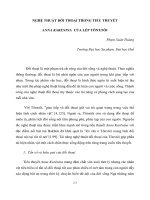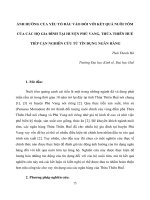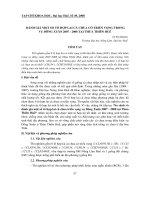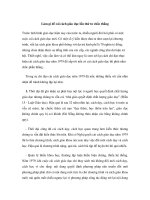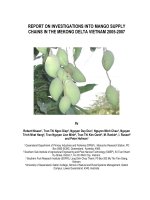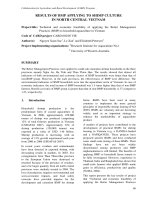Báo cáo nghiên cứu khoa học " MACADAMIA – A PROMISING START TO A NEWHIGH VALUE AGRICULTURAL INDUSTRY FOR VIETNAM " potx
Bạn đang xem bản rút gọn của tài liệu. Xem và tải ngay bản đầy đủ của tài liệu tại đây (8.17 MB, 7 trang )
Collaboration for Agriculture and Rural Development
(CARD)
Program
196
MACADAMIA
–
A PROMISING START TO A NEW HIGH VALUE
AGRICULTURAL INDUSTRY FOR VIETNAM
Project title:
CARD
037/05VIE
-
Establish nurseries and training
to effectively propagate
high quality
trees and trial plantation models of Macadamia in 3 provinces of North Vietnam
Code of the project
: CARD 037/05 VIE
Authors:
Prof. Hoang Hoe
1
, Martin Novak
2
and Kim Wilson
2
Project Implementing organisations:
1
Center for Environment, Tourism and Development, Vietnam
2
Subtropical Farm Forestry Association, Australia
1.
Introduction
The enthusiastic and far sighted support from
key members of the Vietnamese government
particularly that of Vice Prime minister of the
time Mr Cong Tan who introduced macadamia
to Vietnam and Minister Bong, contributed
greatly to the overall success of the project and
the developments in the industry to date. The
Vietnamese project director,
Prof. Hoang Hoe,
through his vision and dedication, has brought
the project to a successful conclusion. Several
years of careful planning and preparation and 5
years of project implementation by the
professor, with assistance from the Australian
project d
irector Martin Novak and by
Australian Macadamia Society (AMS) Chair
Kim Wilson, have culminated in outcomes that
significantly enhance the development of a
macadamia industry in Vietnam.
The project has been made possible through
the support of the Austra
lian and Vietnamese
government under framework of the AusAID
-
funded CARD program
(
) and by the hard
work and collaboration of all of those
involved, including the enthusiastic farmers,
the agenc
y partners, the CARD program team,
and also the private enterprises.
The project, spanning 5 years has helped to
bring all the stakeholders together to work
toward a sustainable high value macadamia
industry for Vietnam. Beneficiaries have
included farmers
, nursery and farm staff and
workers, technicians, extension staff, state and
private companies, government agencies, other
businesses and households.
The activities of the project have gained
support from the Provincial governments and
People’s Committees
of 5 provinces of
Vietnam including Hanoi, Hoa Binh, Lang
S
on, Ba
V
i, and Dak
L
ak.
5 Macadamia training workshops have been
held in these 5 provinces. There has also been
training and new technology presented to field
staff in all of the relevant agencies
in these
provinces. The workshops involved presenters
from Australia, China, Thailand and Vietnam,
who have contributed significantly to this
training and technology transfer stemming
from researchers recommendations.
CARD 037/05 VIE
–
Development of Macadamia
197
A focus to strengthen the capacity o
f a new
demonstration nursery and 3 existing nurseries
involved in growing macadamia by way of
participatory workshops and infield training,
has been maintained throughout the duration of
the project. In addition to this technical
assistance select varieti
es and equipment, has
been provided to FSI and WASI also.
This capacity building has been achieved by
way of:
Collaborative preparation of technical
information and training material.
Delivery of information, and training at
workshops and in the field.
D
elivery of seed and graft stock of at
least 17 best bet Varieties.
Delivery samples of nursery
equipment, including grafting planes,
tape, wounds dressing, propagation and
potting mix, and potting bags.
Establishment of 2 new demonstration
nursery based on
Australian nursery
practice. Encouraging investment from
the private sector and by ensure
adequate supply of quality grafting
stock of suitable varieties.
Preparation and delivery of nursery
business plans, records and monitoring
systems.
The project has
facilitated the trial of 14
varieties of macadamia in 4 different provinces
including Ba
V
i, Hoa Binh, Dak
L
ak and Lang
S
on.
This has involved the design and planting
of 4 trial plots in these provinces.
The project has provided seed and graft wood
of 17 v
arieties, to the demonstration nursery,
the 4 project partnered research nurseries, as
well to FSI and WASI. In addition to this the
project has provided nursery equipment
including grafting planes, graft wounds
dressing, samples of potting bags and
inform
ation via DVD video, CD and hardcopy.
Craig Hardener (CSIRO) and Kim Wilson
(AMS) principally undertook the design of the
trials. Both have extensive experience with
variety trials in Australia. Dr Kha FSI and Prof
Hoang Hoe provided review of the design.
The project team has also facilitated the
development of a Macadamia Association of
Vietnam, which will help coordinate the
sustainable long term development of the
industry, including the planning of research
priorities and an industry development
strate
gy.
The project has been promoted via the public
media, including national and regional TV,
magazines, newspapers and a media seminar.
This has helped to promote the objectives of
the project specifically and the benefits of a
macadamia industry for Vietna
m in general.
2.
Research contents and methods
The project focused on 3 aspects of research;
firstly macadamia variety selection trials,
secondly nursery production options of quality
macadamia trees and thirdly a developmental
strategy for a new macadami
a industry for
Vietnam.
2.1
Established 3 variety trials and
reviewed existing trials of Forest
Science Institute (FSI) and Central
Highland Agriculture Forestry
Science & Technology Institute
(WASI)
14 macadamia varieties have been selected for
the proje
cts 3 variety trials. These include 10
best bet varieties from Australia and 4 from
China. They include 264, 344, 741, 849, 816,
842, 814, A4, A38, A16, based on variety trials
from Australia. Guy Yan1, 695, 788, OC were
selected from China.
The trials si
tes were initially established in 3
provinces including Ba Vi, Hoa Binh and Lang
Son in the subtropical northern parts of
Vietnam in 2007 and 2008. In 2009 an
additional 2 have been established in
Dak
L
ak
,
as it became evident due to the trials of FSI
and
WASI that the central tablelands was the
most promising region to grow macadamia in
Vietnam.
FSI planted the first macadamia seedlings at
Ba vi in 1993
-
4. Over the past 7 years they
have established trials to test varieties, 900,
856, 842, 246, 344, 800, 7
88, 816, H2, NG8,
OC, Daddow, 741 and 849 in 16 trials in 6
provinces. These trials range in age from 4
-
7
years just old enough for early analysis in
Hoang Hoe, Martin Novak & Kim Wilson
198
relation to kernel. They have been collecting a
range of data of survival, growth, flowering
and fruit pro
duction.
From 2002
-
2009, WASI has imported five
varieties originating from China (H2, 508, OC,
814, 344), 6 varieties originating from
Thailand (H2, 508, 246, 344, 741, 660), 8
varieties derived from Australian and has
grown at the Institute on an area of
1.5 ha, the
density is 400 trees/ha to conduct research.
The selection criteria include; the yield, nut
quality and the ability to grow.
2.2
Nursery options for quantity and
quality production of macadamia
trees
The capacity of existing nurseries in term
s of
quantity and quality has increased, over the 5
years of the project, producing
over 330,000
seedlings (2008
-
30,000 trees) and 10,000
grafted trees of 10
–
17 varieties. Nursery
production data has been progressively
collected and a spreadsheet analysis
model has
been prepared and updated for nursery data
and financial returns.
The principal 3 commercial nurseries have
produced and sold some grafted trees at prices
ranging from 30
–
55,00 VND per tree (2008
-
30
-
40,00 VND) and a small quantity have
been util
ised in trials and pilot plantings. Data
on volume is far more readily available than
data on quality, which continues to be mostly
determined by survival at this point in time.
The new private sector nurseries run by
Vinamaca Co have raised the standards
both in
quality and quantity setting a benchmark for
the rest of the industry. The demonstration
nursery at Yen Thuy, supported by this project,
continues to grow quality seedlings and grafted
trees. However, the focus of potential
sustainable development
has turned towards
the central highlands so it was decided to send
grafted trees to
Dak Lak
and establish
demonstration nurseries there.
2.3
A developmental strategy for a new
macadamia industry for Vietnam
This project has worked towards the formation
of
a Macadamia Association of Vietnam,
which will play a key role in managing
developmental issues particularly in helping to
balance the interests of the industry and all its
stakeholders.
An interim committee involving government
and private sector stake
holders, has been
formed in Dak Lak and a Constitution is being
drafted based on the AMS.
3.
Research results and discussions
3.1
Established 3 variety trials and
reviewed existing trials of Forest
Science Institute FSI and WASI
Trials will need to be
6
-
7 years old before data
can be analysis to provide early indication of
the performance of varieties based on kernel,
the key criteria.
Van Linh Station
–
variety trial
Density
–
7m x 4m, 14 varieties, 5 trees /
variety (3 monitored), Replicated 4 time
s
Trees required: 14 varieties x 5 x 4 = 280,
Buffer trees = 108, Total 388 trees
Total area = 1.1 ha.
Progress as at October 2008:
0.62 Ha Planted March 2007, 5m x 4m
= 500 trees / Ha. 312 trees fully
planted. Recording growth every 3
months, Recorded tr
ial layout &
varieties. Trees require more fertiliser.
Progress August 02,2010:
Trial plot 1
: 47 trees of H2 +
741(planted in 2003) 7 years old:
growing well, spacing 3mx3m too
dense ( H=5m, ) harvest 120kg NIS
(2009) estimate 150 kg NIS ( 2010)
Trial plot
2
: planted in Nov.2007 trees
growing well ( 60%) H2, 5M
-
3,0M,
40% trees look not so good, there are
some trees have a few early fruit (3
years
-
old) fruit mostly size big.
Ba vi Station
–
variety trial
Density
–
7m x 4m, 14 varieties, 10 trees /
variety (8
monitored), Replicated 4 times.
Trees required, 14 varieties x 10 x 4 = 560,
Buffer trees = 102, Total 662 trees.
Total area = 1.85 ha.
CARD 037/05 VIE
–
Development of Macadamia
199
Progress as at October 2008: .
85 Ha. Planted January 2007, 4m x
2.5m = 1000 trees / Ha, 825 trees fully
planted. Rec
orded trial layout &
varieties, Recording costs.
Progress at January 14,2010
Trials plot 1
: 240 trees of 19 varieties(
from Australia & China), 5
-
6 years
-
old,
look good. H= 6
-
7 M. All varieties
show Green leaves. Harvested in
October 2009, total fruit 250
Kg, 119
Kg NIS. [Compare with the trial plot of
farm of Mr. Thu in Krong nang
Dak
Lak
, 6 years old trees, total harvested
600 Kg of NIS. Indicates that
difference in the climate, has
significant influence.
Trial plot 2
:
2007 planted 1000 trees,
now H=2
-
3m,
50% of trees good, the
rest not so good smaller and poorer
color for all varieties.
Trial plot 3
:
Jan 2008 they planted 2
Ha ( 660 trees) in Bavi, look about
50% trees good H=2
-
2,5 M, green
leaves.
Progress at March 2010:
Plot 2
: 1 ha planted 2007 & flow
ering.
Plot 3
: 600 trees planted 2008 half do
not look healthy at this time. 2009 crop
400 trees produced 250 kg NIH 119
NIS used for seed nut. Flowering time
was in April. 695 had lots flowers.
Overall not much nut set due to lacked
of water & nutrition
. Collecting data on
nut yield, measure flowering and fruit.
7 trees died in trial plot 3. Fertiliser 1kg
NPK x 2 pa will do not yet done Plus 5
-
10 kg organic manure.
Progress at July 2010:
There are some early fruit on the trees
of trial plot 3 after a
good flowering in
March
–
April (2008 planting)
Yen thuy
–
variety trial.
Density
–
7m x 4m, 14 varieties, 10 trees /
variety (8 monitored), Replicated 4 times
Trees required, 14 varieties x 10 x 4 = 560,
Buffer trees = 128, Total 688 trees
Total area = 1.9
ha.
Progress as at October 2008:
Yen thuy trial plot, planted Spring
2008. Trees look good new flush.
Progress as at July 2010:
Newly planted 02 ha of trial plot (Yen
1 ha, Duc 1 ha) (600 trees)
Vinamaca Co
–
Additional New 2009
Macadamia variety trial
.
Village
:
Ka Mang
,
Commune
:
Deliza
District
:
Krongnoang Province
:
Dak
L
ak.
Total area 1.3ha including trial plot buffer
trees fully fenced. Transplanted from Yen
Thuy Nov 2009 360 grafted trees most
tagged.
FSI
-
variety trials
Research indicates that a nu
mber of
varieties are performing well in Vietnam.
The key findings are included in the full
report as follows:
-
In Dong Hoi (Quang Binh) varieties,
OC, 741, 816 246 grow well and the
bearing fruit rate is high.
-
In Krong Nang, Dak Lak, varieties 842,
800, 8
49,246, 741 and OC grow well
and the bearing fruit rate is high
-
In Mai Son, Son La, varieties OC and
246 grow well and are capable of
bearing fruit.
-
In Drakpao, Dak Nong, varieties 816,
OC, NG8, MC2 and A800 grow well.
-
In Dai Lai, Vinh Phuc, varieties 816,
246, OC, A800 and Daddow grow well.
-
In Ba Vi bear buds from December to
the following February. Flowers bloom
from March to April, bearing fruits
from the end of April to June, fruits
ripe and fall from December to
November. The length of flowers is
from
11.1 to 21.6. Number of flowers is
226 to 453, bearing fruits rate is 0.02 to
1.6 %. Radiance of fruits is from 2.8 to
3.2 cm.
-
There are differences in the blooming
time, so it is necessary to grow the
varieties with same blooming time
together. This makes
it easier for trees
of different varieties to inter
-
pollinate
Hoang Hoe, Martin Novak & Kim Wilson
200
and increase bearing fruits rate. For a
high
-
productive garden we should grow
trees of different varieties together:
(900, 856, 842, 246, 344); (800, 788,
816, H2); (NG8, 800, 856, OC,
Daddow,
816); (741, OC, Daddow,
816, 849).
WASI
–
variety trials
Findings include the following:
-
Macadamia imported from China after
6 years have been growing well. All the
varieties can produce flowers and
fruits. Percentage of flowering plant of
all the varietie
s is 100%; currently three
varieties have high rate of flowering
and producing fruit are H2, 508 and
OC.
-
Initially OC is seen as a quite suitable
variety with the ecological conditions
in Dak Lak. It has high potential yield,
large seed size, less pest an
d in
particular, the balanced canopy; it is
also solid, drought
-
resistant and well
adapted to the weather conditions in the
Central Highlands.
-
The macadamia from Thailand after
more than 3 years of planting have
been growing well. There is currently
no pe
st risk.
3.2
Nursery production options for
quality macadamia trees
Macadamia nurseries technical data 30 April 2010
Organization
Technical data
FSI
WASI
NERFSE
Lang son
(March 2008)*
Long
Phuong
(Yen Thuy)
Khan
Khina
(Ba vi)
Vina
-
maca
(Dak lak)
Area
(Sqm)
500
250
2500
1000
2000
15000
No of Seedlings
2000
300
3700
5000
80,000
220,000
No of Grafted trees
1500
300
2000
400
15,000
3000
Graft success rate.
75%
70%
60%
60%
75%
80%
No of Varieties AU
7
5
3
11
6
4
No of Varieties CN
3
3
5
4
4
No of Varieties VN
3
No Varieties Thai
4
Cost of tree
20,000
30,000
25,000
Price of tree
40,000
42,000
35,000
50,000
35
-
40,000
*
Note:
NERFSE has stopped nursery production and purchases seed and trees
from China most of
which are sold to farmers in central highlands.
Long Phuong Company is responsible for the
establishment of the new demonstration
nursery at Yen Thuy. It now found joint
venture partners and established Vinamaca
Co., which has set up m
uch larger nurseries in
Daklak totalling approximately 250,000
seedlings, and 3000 grafted trees this year to
date. Ba vi nursery has also expanded
production significantly from 7000 seedlings
and 1000 grafted trees in 2008 with a success
rate of 65% to 8
0,000 seedlings and 15,000
grafted trees and success rate of 75% in 2010.
Lang son has scaled back on nursery
production because of nut set problems in the
region due to high humidity and moist
conditions during flowering. However the
center is using its k
nowledge with macadamia
propagation and its strong relationship with
Chinese researchers to obtain quality seed and
scion wood for plantation requirements in
Vietnam particularly for the central highlands.
3.3
A developmental strategy for a new
macadamia
industry for Vietnam.
The interim committee of the Macadamia
Association and the project team are
developing an industry strategy, guidelines and
priorities. Recommendations include:
Form a Macadamia Association of
Vietnam to help implement the
following r
ecommendations.
Form a research and development
committee to facilitate and prioritise
CARD 037/05 VIE
–
Development of Macadamia
201
research and help coordinate research
bodies and activities.
Develop strategies to overcome cash
flow issues for farmers.
Develop a macadamia tree database.
Membership
fee structure needs to be
set and other financial support needs
to be identified to assist the industry.
The association needs to represent all
stakeholders of the industry,
government and private and both will
need to support this development. It
is envis
aged that MARD will be the
key supporting government agency.
The association needs to develop
guidelines for nursery accreditation
such as that of the South African
model rather than the long
-
term
accreditation of varieties.
Collaboration should be maintai
ned
with Australia, China and Thailand.
An industry promotions strategy developed by
a committee needs to be designed.
4.
Conclusions and recommendations
4.1
Conclusions
This projects principal aim was to assist the
start of a commercial macadamia indust
ry in
Vietnam in order to improve the income flow
of the farmer and the rural sector. The general
feeling is that it has been successful in
achieving this aim.
Vietnam now has a macadamia industry in its
early phase of development. There are over
350,000
macadamia trees of suitable quality
and varieties, in the nurseries. Most of these
nurseries now have the capacity to expand
their production of quality trees. There are a
range of macadamia trials in 12 provinces and
several hundred hectares of commercial
plantations being established by smaller
farmers and large commercial enterprises, with
preparations under way for hundreds more to
be established. Financial modelling undertaken
by the project indicates good returns for both
nurseries and plantations. In
addition to all this
the country now has a large commercial
processing plant near Ho Chi Minh city and
another planned for Thai
Binh
in the north of
the country.
It is too early to provide recommendations
with regard to suitable macadamia varieties for
V
ietnam. It takes 6 to 7 years before
meaningful data is available and 15 to 20 years
before varieties can be fully assessed as to
sustainable production of good quality kernel.
Certification of varieties cannot be made until
the research has run its course
. It needs to be
noted that varieties are not certified anywhere
else in the world. Certification of nurseries is
underway in South Africa and under
consideration in Australia. This is something
that MARD and the Macadamia Association
need to consider very
carefully. However, the
varieties chosen for the 3 project trials are
considered by the project team to have shown
promise at this stage. They include 842, 741,
246, 814, 816, 849, 344, A4, A16 and A38
from Australian and QN 1, 695, 788 and O.C
from China
.
After 5 years of project implementation and
research activities of FSI and WASI,
it has
become evident that there is high potential for
macadamia
plantings in some regions,
especially central highland areas and to some
extent in the north west of the co
untry.
4.2
Recommendations
Continue research in the performance of
macadamia varieties particularly in regards
to quality and yield of kernel.
Continue research into the cost effective
establishment and maintenance of
macadamia orchards.
Continue educat
ion and training of
farmers, plantation managers, extension
staff and technicians.
Form a macadamia association of Vietnam
and implement recommendations detailed
in the section 3.3 above.
REFERENCE
CARD Project Milestone Reports 3, 6, 11, 12 & 13
reports &
attachments.
Macadamia :
-
Macadamia and potential of planting in
Hoang Hoe, Martin Novak & Kim Wilson
202
North of Vietnam
( by Nguyen Cong Tan
-
Agricultural Publishing House 2005)
-
Growing Macadamia in Australia.
Agricultural P
ublishing House 2003
-
Le
Dinh Kha interpreted
-
Macadamia Grower’s Handbook
(
Giáo trình
ngư
ờ
i tr
ồ
ng Măc ca)
-
Macadamia problem solver & bug identifier
-
Macadamia varieties handbook
Hardner C, McConchie CM 2003.
The future of
macadamia genetic improvement in
Australia.
In: 2nd International Macadamia
Symposium 2003. pp 85
-
89.
Australian
Macadamia Society, Lismore Australia.
Hardner C 2002. Progress in MC98009:
Rootstock
Evaluation for the Australian
macadamia industry.
Australian Macadamia
Society News Bullet
in. 29
Stephenson RA, Gallagher EC, Winks CW, Firth D
1993.
The breeding, selection
and development of new macadamia cultivars for
the Australian industry
. Final
report, project MC014.
Horticultural Research and
Development Corporation,
Australia.
Supattra Supamatee, et al
1992
Early performance
of Australian and Hawaiian Macadamia Cultivars
in Thailand
Department of
Agriculture, Bangkok,
P. Allan,
2001 Macadamia Cultivar Evaluation at
Pietermaritzburg and Identification in South Africa
Horticultural Science, University of Natal, South
Africa,
